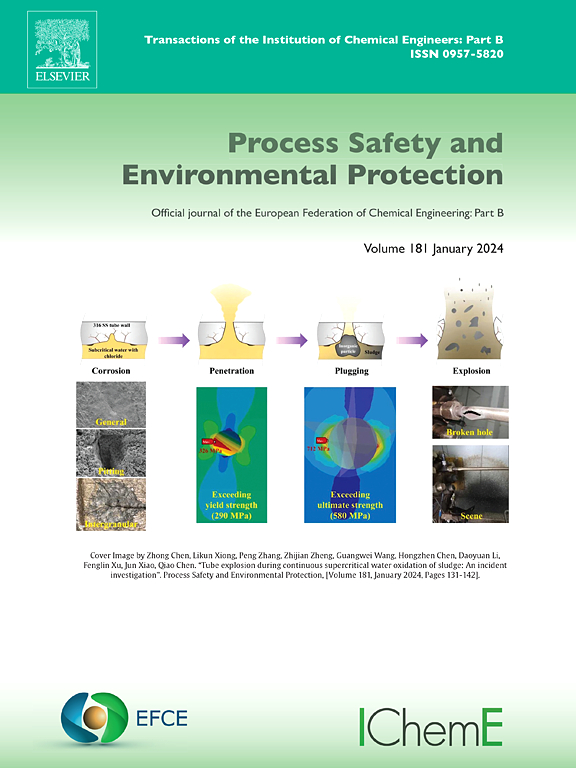Engineering of cubic facet ZIF-8 derivative carbon by supercritical-CO2 approach: An advanced standalone electrode modifier for the detection of toxic nitrofuran (furaltadone) in aquaculture water
IF 6.9
2区 环境科学与生态学
Q1 ENGINEERING, CHEMICAL
引用次数: 0
Abstract
The uncontrolled discharge of toxic contaminants, like furaltadone (FTD), a nitrofuran antibiotic utilized in animal farming, embodies a grave risk to both ecology and public health. Developing sustainable methods for detecting these harmful impurities has become a key area of research. To address these challenges, we developed a sustainable zeolitic imidazolate framework-8 derivative carbon (Z8-C) employing a supercritical-CO2 (SC-CO2) approach (S-Z8-C) and modified onto a screen-printed carbon electrode (SPCE) to create an ultra-responsive interface for FTD detection. To gain research insights into the SC-CO2, Z8-C was prepared using a conventional method (C-Z8-C) for comparison. The prepared materials were examined using comprehensive physicochemical characterization. These results revealed that the surface of C-Z8-C exhibits a smooth hexagonal structure, whereas S-Z8-C features a cubic facet, respectively. The SC-CO2 process significantly influenced the nucleation dynamics and induced morphological transformation. Furthermore, the S-Z8-C/SPCE was used to evaluate its electrocatalytic behavior through voltammetry analyses. The results show a broad linear range, a low LOD of 0.6507 µM, as well as excellent sensitivity, superior selectivity, and high repeatability. Additionally, the real-time operational feasibility of the S-Z8-C/SPCE was examined by spiking FTD into aqua culture water samples, and the recovery yield was determined to be 99.71 %. From the outcomes, the sustainability of the S-Z8-C/SPCE exhibits unique properties that authenticate its efficient electrochemical sensing performance for FTD, positioning it as a viable interface for real-time implementation.
立方面ZIF-8衍生物碳的超临界- co2法工程:一种用于检测水产养殖水中有毒硝基呋喃(呋喃他酮)的先进独立电极改性剂
不受控制地排放有毒污染物,如动物养殖中使用的一种硝基呋喃抗生素呋喃酮(FTD),对生态和公众健康都构成严重威胁。开发可持续的方法来检测这些有害杂质已成为一个关键的研究领域。为了解决这些挑战,我们开发了一种可持续的沸石咪唑盐框架-8衍生物碳(Z8-C),采用超临界二氧化碳(SC-CO2)方法(S-Z8-C),并将其修饰在丝网印刷碳电极(SPCE)上,以创建用于FTD检测的超响应界面。为了深入研究SC-CO2,采用常规方法(C-Z8-C)制备Z8-C进行比较。对制备的材料进行了综合理化表征。结果表明,C-Z8-C表面为光滑的六边形结构,而S-Z8-C表面为立方结构。SC-CO2过程显著影响成核动力学和诱导形态转变。并利用S-Z8-C/SPCE伏安法对其电催化性能进行了评价。结果表明,该方法线性范围宽,LOD低,为0.6507 µM,灵敏度高,选择性好,重复性高。此外,通过在水样中添加FTD,验证了S-Z8-C/SPCE的实时运行可行性,回收率为99.71% %。从结果来看,S-Z8-C/SPCE的可持续性表现出独特的性能,证明了其在FTD上的高效电化学传感性能,使其成为实时实现的可行接口。
本文章由计算机程序翻译,如有差异,请以英文原文为准。
求助全文
约1分钟内获得全文
求助全文
来源期刊

Process Safety and Environmental Protection
环境科学-工程:化工
CiteScore
11.40
自引率
15.40%
发文量
929
审稿时长
8.0 months
期刊介绍:
The Process Safety and Environmental Protection (PSEP) journal is a leading international publication that focuses on the publication of high-quality, original research papers in the field of engineering, specifically those related to the safety of industrial processes and environmental protection. The journal encourages submissions that present new developments in safety and environmental aspects, particularly those that show how research findings can be applied in process engineering design and practice.
PSEP is particularly interested in research that brings fresh perspectives to established engineering principles, identifies unsolved problems, or suggests directions for future research. The journal also values contributions that push the boundaries of traditional engineering and welcomes multidisciplinary papers.
PSEP's articles are abstracted and indexed by a range of databases and services, which helps to ensure that the journal's research is accessible and recognized in the academic and professional communities. These databases include ANTE, Chemical Abstracts, Chemical Hazards in Industry, Current Contents, Elsevier Engineering Information database, Pascal Francis, Web of Science, Scopus, Engineering Information Database EnCompass LIT (Elsevier), and INSPEC. This wide coverage facilitates the dissemination of the journal's content to a global audience interested in process safety and environmental engineering.
 求助内容:
求助内容: 应助结果提醒方式:
应助结果提醒方式:


